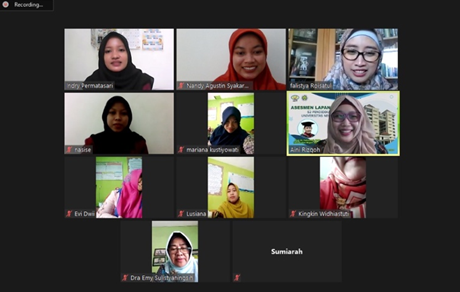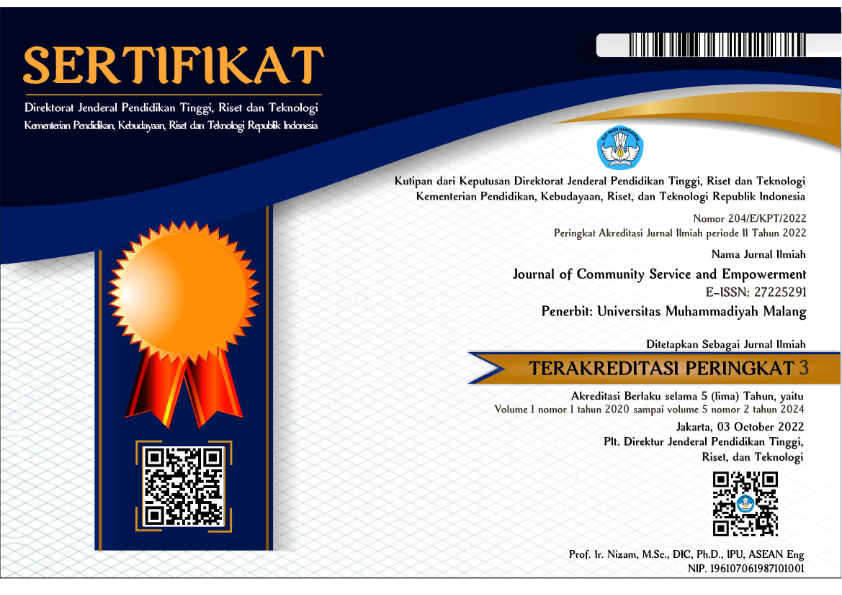Developing guidelines for early detection of child and adolescent mental health problems
DOI:
https://doi.org/10.22219/jcse.v4i1.24424Keywords:
Child mental health , School environment, Teacher roleAbstract
Children, like adults, can suffer from various mental health issues, but they are rarely recognized. This research aims to create early detection guidelines that can be used by those closest to children, such as parents and teachers in schools. The methods used by the team were narrative review, data analysis, preparation of guidelines, expert judgment, and dissemination. Three experts carried out the preparation of the guide. Furthermore, the dissemination was carried out at SDN Girimoyo 02 Karangploso, Malang Regency. The guideline contains six points, namely 1) definition of mental health, 2) description of the child's mental health issues, 3) description of instruments that can be used for screening or early detection, 4) various considerations that need to be considered when conducting screening or early detection, 5) referral system and flow, and 6) the role of teachers in schools and their urgency. Furthermore, the result of the dissemination activity is the increased understanding of teachers in schools regarding the early detection of student's mental health problems so that teachers can be more sensitive to the conditions of their students.
Downloads
References
Boman, F., Stafström, M., Lundin, N., Moghadassi, M., Törnhage, C.-J., & Östergren, P.-O. (2016). Comparing parent and teacher assessments of mental health in elementary school children. Scandinavian Journal of Public Health, 44(2), 168–176. https://doi.org/10.1177/1403494815610929
Dowdy, E., Furlong, M., Eklund, K., Saeki, E., & Ritchey, K. (2010). Screening for mentalhealth and wellness: Current school-based practices and emerging possibilities. In B.Doll, W. Pfohl, & J. Yoon (Eds.), Handbook of youth prevention science(pp. 70–95). New York, NY: Routledge.
Galderisi, S., Heinz, A., Kastrup, M., Beezhold, J., & Sartorius, N. (2015). Toward a new definition of mental health. World psychiatry : official journal of the World Psychiatric Association (WPA), 14(2), 231–233. https://doi.org/10.1002/wps.20231
House of Commons, Education and Health Committees (2017). Children and young people’s mental health: The role of education. First Joint Report of the Education and Health Committees of Session 2016–17. London: UK Parliament. http://dera.ioe.ac.uk/id/eprint/28974
Kamphaus, R., & Reynolds, C. (2015). BASC-3 Behavioral and Emotional Screening System (BASC-3 BESS). Professional Assessments. https://www.pearsonassessments.com/store/usassessments/en/Store/Professional-Assessments/Behavior/Comprehensive/BASC-3-Behavioral-and-Emotional-Screening-System/p/100001482.html
Kim, J., Kim, D; and Kamphaus, R. (2022). Early detection of mental health through universal screening at schools. Georgia Educational Researcher, 19 (1) , https://doi.org/10.20429/ger.2022.190104
KPAI. (2021). Data kasus pengaduan anak 2016 – 2020.
https://bankdata.kpai.go.id/tabulasi-data/data-kasus-pengaduan-anak-2016-2020
Marín-González, E., Malmusi, D., Camprubí, L., & Borrell, C. (2017). The role of dissemination as a fundamental part of a research project: lessons learned from sophie. International Journal of Health Services, 47(2) 258–276. https://doi.org/10.1177/0020731416676227.
Massachusetts General Hospital Psychiatry. (2019). Pediatric symptom checklist (PSC). Overview. https://www.massgeneral.org/psychiatry/services/treatmentprograms.aspx?id=2088
Medical Home Portal (2022). Mental health screening for children & teens. https://www.medicalhomeportal.org/clinical-practice/screening-and-prevention/mental-health-screening-for-children-and-teens
Moor, S., Maguire, A., McQueen, H., Wells, E., Elton, R., Wrate, R. & Blair, C. (2007). Improving the recognition of depression in adolescence: Can we teach the teachers? Journal of Adolescence, 30(1), 81-95. https:// doi.org/10.1016/j.adolescence.2005.12.001
O'Malley M, Voight A, Renshaw TL, Eklund K. (2015). School climate, family structure, and academic achievement: a study of moderation effects. Sch Psychol Q, 30(1):142-157. https://doi.org/10.1037/spq0000076.
University of Missouri. (2014). Social, Academic, and Emotional Behavior Risk Screener (SAEBRS). http://ebi.missouri.edu/?p=1116 23 Ci3T.org. (2021). Student Risk Screening Scale—Internalizing and Externalizing (SRSS-IE). https://www.ci3t.org/screening
Walker, H., Severson, H., & Feil, E. (2014). Systematic Screening for Behavior Disorders (SSBD): Administrators guide, universal screening for PreK–9 (2nd ed.). Pacific Northwest Publishing. https://www.ancorapublishing.com/wp-content/uploads/2018/08/SSBD Portfolio.pdf
Wiles, R., Crow, G., & Pain, H. (2011). Innovation in qualitative research methods: a narrative review. Qualitative Research, 11(5), 587–604. https://doi.org/10.1177/1468794111413227
World Health Organization. (2004). Promoting mental health: concepts, emerging evidence, practice (Summary Report) Geneva: World Health Organization
Youth in Mind. (2016). Strengths and Difficulties Questionnaire (SDQ). https://www.sdqinfo.org/

Downloads
Published
How to Cite
Issue
Section
License
Copyright (c) 2023 Nandy Agustin Syakarofath, Falistya Roisatul Mar'atin Nuro, M. Karimun

This work is licensed under a Creative Commons Attribution-ShareAlike 4.0 International License.












